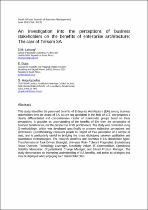 ResearchSpace
ResearchSpace
An investigation into the perceptions of business stakeholders on the benefits of enterprise architecture: the case of Telkom SA
JavaScript is disabled for your browser. Some features of this site may not work without it.
- ResearchSpace
- →
- Research Publications/Outputs
- →
- Journal Articles
- →
- View Item
| dc.contributor.author |
Lehong, SM

|
|
| dc.contributor.author |
Dube, E

|
|
| dc.contributor.author |
Angelopoulos, G

|
|
| dc.date.accessioned | 2014-05-28T13:47:38Z | |
| dc.date.available | 2014-05-28T13:47:38Z | |
| dc.date.issued | 2013-06 | |
| dc.identifier.citation | Lehong, S.M, Dube, E and Angelopoulos, G. 2013. An investigation into the perceptions of business stakeholders on the benefits of enterprise architecture: the case of Telkom SA. South African Journal of Business Management, vol. 44(2), pp 45-56 | en_US |
| dc.identifier.issn | 0378-9098 | |
| dc.identifier.uri | http://reference.sabinet.co.za/sa_epublication_article/busman_v44_n2_a5 | |
| dc.identifier.uri | http://hdl.handle.net/10204/7435 | |
| dc.description | Copyright: 2013 Sabinet. This is an ABSTRACT ONLY. The definitive version is published in South African Journal of Business Management, vol. 44(2), pp 45-56 | en_US |
| dc.description.abstract | This study identifies the perceived benefits of Enterprise Architecture (EA) among business stakeholders who are aware of EA but are not specialists in the field of ICT, and proposes a clearly differentiated and comprehensive cluster of stakeholder groups based on these perceptions. It provides an understanding of the benefits of EA from the perspective of business beneficiaries, not the perspective of its practitioners. The study was conducted using Q-methodology, which was developed specifically to uncover subjective perceptions and preferences. Q-methodology correlates people in respect of their perception of a sample of tests, and is particularly useful in bridging the sharp dichotomy between qualitative and quantitative methodologies. The research identifies and describes 9 EA stakeholder types: Transformational Task-Driven Strategist, Universal Risk-Tolerant Pragmatist, Evolutionary Reuse Overseer, Technology Leverager, Simplicity Valuer, IT Commoditiser, Operational Stability Maintainer, Organisational Change Manager, and Siloed Product Manager. The study demonstrates an increasing understanding of EA benefits, and points to strategies that may be deployed when engaging each stakeholder class. | en_US |
| dc.language.iso | en | en_US |
| dc.publisher | Sabinet | en_US |
| dc.relation.ispartofseries | Workflow;12706 | |
| dc.subject | Telkom SA | en_US |
| dc.subject | Enterprise architecture | en_US |
| dc.subject | Business stakeholders | en_US |
| dc.subject | Q-methodology | en_US |
| dc.subject | Business stakeholders | en_US |
| dc.subject | Organisational Change Manager | en_US |
| dc.subject | Transformational Task-Driven Strategist | en_US |
| dc.subject | Universal Risk-Tolerant Pragmatist | en_US |
| dc.title | An investigation into the perceptions of business stakeholders on the benefits of enterprise architecture: the case of Telkom SA | en_US |
| dc.type | Article | en_US |
| dc.identifier.apacitation | Lehong, S., Dube, E., & Angelopoulos, G. (2013). An investigation into the perceptions of business stakeholders on the benefits of enterprise architecture: the case of Telkom SA. http://hdl.handle.net/10204/7435 | en_ZA |
| dc.identifier.chicagocitation | Lehong, SM, E Dube, and G Angelopoulos "An investigation into the perceptions of business stakeholders on the benefits of enterprise architecture: the case of Telkom SA." (2013) http://hdl.handle.net/10204/7435 | en_ZA |
| dc.identifier.vancouvercitation | Lehong S, Dube E, Angelopoulos G. An investigation into the perceptions of business stakeholders on the benefits of enterprise architecture: the case of Telkom SA. 2013; http://hdl.handle.net/10204/7435. | en_ZA |
| dc.identifier.ris | TY - Article AU - Lehong, SM AU - Dube, E AU - Angelopoulos, G AB - This study identifies the perceived benefits of Enterprise Architecture (EA) among business stakeholders who are aware of EA but are not specialists in the field of ICT, and proposes a clearly differentiated and comprehensive cluster of stakeholder groups based on these perceptions. It provides an understanding of the benefits of EA from the perspective of business beneficiaries, not the perspective of its practitioners. The study was conducted using Q-methodology, which was developed specifically to uncover subjective perceptions and preferences. Q-methodology correlates people in respect of their perception of a sample of tests, and is particularly useful in bridging the sharp dichotomy between qualitative and quantitative methodologies. The research identifies and describes 9 EA stakeholder types: Transformational Task-Driven Strategist, Universal Risk-Tolerant Pragmatist, Evolutionary Reuse Overseer, Technology Leverager, Simplicity Valuer, IT Commoditiser, Operational Stability Maintainer, Organisational Change Manager, and Siloed Product Manager. The study demonstrates an increasing understanding of EA benefits, and points to strategies that may be deployed when engaging each stakeholder class. DA - 2013-06 DB - ResearchSpace DP - CSIR KW - Telkom SA KW - Enterprise architecture KW - Business stakeholders KW - Q-methodology KW - Business stakeholders KW - Organisational Change Manager KW - Transformational Task-Driven Strategist KW - Universal Risk-Tolerant Pragmatist LK - https://researchspace.csir.co.za PY - 2013 SM - 0378-9098 T1 - An investigation into the perceptions of business stakeholders on the benefits of enterprise architecture: the case of Telkom SA TI - An investigation into the perceptions of business stakeholders on the benefits of enterprise architecture: the case of Telkom SA UR - http://hdl.handle.net/10204/7435 ER - | en_ZA |





